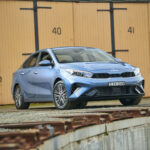
When you’re on to a good thing, it’s time to charge more for it. At least that is the
philosophy Kia seems to have adopted with its popular boy racer Cerato GT.
When the car was released, it was $31,990 driveaway for hatch or sedan, a bargain for the
kind of performance it offered.
Cerato GT is still a good thing, but not the bargain it once was, as the price has steadily
crept north. Nowadays, you’ll pay $36,990 — or about 15 per cent more for the same thing.
Just saying . . .
STYLING
Cerato GT is a great alternative for those who can’t afford the Kia Stinger. It’s not as big, or
as impressive to look at, but certainly Fun to drive with a capital ‘F’ — and that’s the all-
important thing.
Now in its second iteration, with flashier, more radical styling, you get some added value
for the extra five grand.
A top and tail sees restyled headlights, radiator grille, front bumper and fog lights.
While the rear gets updated tail lights, boot and rear bumper lines, the sedan that is – the
hatch stays largely the same.
Consulting the fine print and it says leather appointed “may comprise” of genuine leather,
polyurethane and other man-made materials or a combination thereof (you never can tell).
Sporty bits include a body kit, dual exhausts, paddle shifters, alloy sports pedals and a flat-
bottomed leather sports steering wheel.
INFOTAINMENT
Infotainment consists of a larger 10.25-inch touchscreen and 8-speaker JBL audio,
Bluetooth, DAB digital radio, satellite navigation with 10-year map updates and SUNA live
traffic updates, wired Apple CarPlay and Android Auto with voice recognition and a
wireless phone charger.

ENGINES / TRANSMISSIONS
Power comes from a 1.6-litre turbo-petrol four-cylinder that produces 150kW of power at
6000 rpm and 265Nm of torque from 1500-4500 rpm.
Drive is to the front wheels through a 7-speed dual-clutch transmission.
Sorry, guys n’ gals — but there’s still no manual. In fact, the six-speed manual gearbox has
been deleted from the entire lineup.
SAFETY
Safety-wise the GT is right up there with six airbags, Auto Emergency Braking, with
Pedestrian and Cyclist recognition, Forward Collision Warning, Lane Keep Assist, Blind
Spot Alert, Rear Cross Traffic Alert, Rear View Camera, Driver Attention Alert, plus front
and rear parking sensors.
For child seats three anchor points, two IsoFix attachments are provided.
DRIVING
Our test car this time around was the hatch, although we prefer the look of the sedan.
The hatch also weighs about 25kg more, not much but as they say — every bit counts.
Cerato received a mid-life update in June last year and as part of that update, engineers
did a bit more work on the suspension setup.
The enhanced sports tune we’re told is designed to provide a better balance of ride and
handling, particularly when it comes to rough roads and stability in corners.

Fuel consumption is a claimed 6.8L/100km for hatch and 6.9L/100km for the sedan. On
test we used 7.2 litres per hundred kilometres so the official figure isn’t too far off the mark.
There are four drive modes, with Smart, Eco and Comfort accessed via a switch — plus a
hidden Sport mode of sorts.
Smart adapts to your style of driving. Sport mode is accessed by pulling the gear shift
towards you, which sharpens steering and delivers faster, more aggressive gear shifts.
The GT rides 10mm lower than a standard Cerato, with upgraded, independent rear
suspension, to make it ride and handle better, particularly when driven with enthusiasm.
Larger 305mm by 25mm ventilated front discs are fitted, with 18-inch sport rims and grippy
225/40Z R18 Michelin Pilot Sport 4 rubber. A space saver spare is provided.
The twin-clutch auto stamps its own character on the drive experience, offering fast
seamless gear changes via steering wheel mounted paddles.
When you’re up it, the transmission stands ready to respond at an instant, but has a
tendency to doze off after you have been cruising along for a while. By that, I mean it
takes a second or two to swing into action if you suddenly ask it the question — for
instance to make a quick overtake.
GT’s steering carries over highlighting the difference between Normal and Sport modes.
The beefier brakes are more than up to the job, with plenty of bite even after repeated
hard application going into corners.
Kia’s tuning gurus have done a remarkable job considering they started with a car that is
little more than a shopping trolley.
But you pay for it as a daily driver with a ride that is quite firm with little suspension travel
to soak up bumps in the road.
In fact, compared to the car we drove in 2019, the ride is worse, suggesting the changes
they made were targeted primarily at making it handle better — in other words further
screwing down the suspension.
It takes standard unleaded, but really, you’d have to be crazy not to feed this one the good
stuff — for the performance alone.
SUMMING UP
To be honest, I think the car has lost some of its appeal, either that or the rest of the
market has caught up.
Given the choice, I’d opt for the sedan and original suspension setup which I reckon was
more compliant, especially as a daily driver.
On the plus side the GT still offers that rare combination of style, value and performance
that doesn’t come along very often.
AT A GLANCE
MODEL RANGE
S 2.0-litre petrol hatch & sedan: $25,990
Sport 2.0-litre petrol hatch & sedan: $27,990
Sport + 2.0-litre petrol hatch & sedan: $31,690
GT 1.6-litre turbo-petrol hatch & sedan: $36,990
Note: These prices do not include government or dealer delivery charges. Contact your
local Kia dealer for drive-away prices.
SPECIFICATIONS (Kia Cerato GT, 1.6-litre turbo petrol, sedan and hatch)
PERFORMANCE:
Capacity: 1.6 litres
Configuration: In-line 4cyl DOHC T-GDI3 D-CVVT2 16 valve
Maximum Power: 150kW @ 6000 rpm
Maximum Torque: 265Nm from 1500 – 4500 rpm
Fuel Type: Regular Unleaded:
Combined Fuel Cycle (ADR 81/02): 6.9L/100km (sedan), 6.8L/100km (hatch)
CO2 Emissions: 157 g/km (sedan), 158 g/km (hatch)
DRIVELINE: 7-speed dual clutch transmission (DCT), front-wheel drive
DIMENSIONS, WEIGHT AND CAPACITIES:
Length: 4640 mm (sedan) 4510 mm (hatch)
Wheelbase: 2700 mm
Width: 1800 mm
Height: 1435 mm (sedan), 1440 mm (hatch)
Turning Circle: 10.6 metres
Kerb Mass: 1370kg (sedan), 1395kg (hatch)
Fuel tank capacity: 50 litres
BRAKES:
Front: 305 mm ventilated discs
Rear: 284 mm solid discs
STANDARD WARRANTY:
Seven years/Unlimited kilometres
RATINGS:
Looks: 8/10
Performance: 8/10
Safety: 8/10
Thirst: 8/10
Practicality: 8/10
Comfort: 7.5/10
Tech: 8/10
Value: 8.5/10
Overall: 8/10











